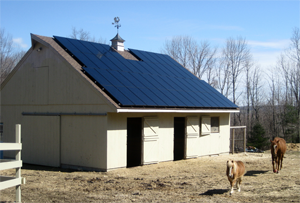Year one of our great solar energy adventure came to an end in January 2009. It was a learning experience. When all was said and done, we produced an impressive 11,502 kW of clean energy, compared to the 11,528 predicted by Dave Cohen of Solarwrights.
 |
The Wesler's solar set up. To date, they have been able to prevent 21,700 pounds (that’s about ten tons!) of carbon dioxide from going into the atmosphere. Lee Wesler photo. |
| COMING SOON: Two great opportunities to obtain more information about clean energy options: 1) Earth Day event on April 25th at the Woodstock Town Hall. 2) Source to Sea event at Roseland Park in Woodstock on May 9th. Both are free and open to the public. |
In the meantime, much has changed at the national, state and local levels. Woodstock now has a Green Team led by the venerable Jim Stratos. Pomfret plans to place solar system on its Community School, although the project is currently on hold until state funding details can be resolved. They have also formed their own Green Team. All of this bodes well for the future of renewable energy in the Last Green Valley, and for solar energy in particular. Energy independence is an important step towards national security and environmental stability.
To recap, last year we installed a forty-eight panel photovoltaic solar system on the southern roof of our horse barn. It went relatively smoothly, in spite of a pesky plan-eating pony that has since been traded in for a less impish miniature horse.
The system has worked perfectly. We entered November with a surplus of 2200 kW in "the bank." Some of the excess was from replacing existing light bulbs with newer energy efficient ones and some new Energy Star appliances. Because there was little to gain by keeping a positive balance at year end (CL&P buys it back for a nominal amount), and the price of oil was running high, we decided to heat the house with electric space heaters. That turned out to be a mistake. We were lax in setting the temperature. Since December was unusually cloudy, the amount of electricity generated in the entire month equaled what the system typically churned out on just one spring day. In the end, we enjoyed no electric bill for most of the year, but did have to pay in December and January.
For those interested in their own solar system, there are several new developments. First and foremost is reduced reimbursement from the State as of October 2008. The initial $5/watt for the first 5 kW and 4.30/kW for the next 5 kW has dropped to $4 and $2.30, respectively. This is moot, as there is no money left in the program. It also makes the increase in the federal tax deduction from $2000 to 30% of the array moot, as the cost of the system becomes prohibitive.
On the other hand, there is now a more affordable way to finance an array--leasing. A 48-panel system like mine can be had for the average cost of a monthly electric bill over the course of 15 years. This also negates the cost of replacing solar inverters (boxes that change the electrical current from DC to AC), which usually last about 15 years. The bottom line is that you can now have your cake and eat it too. You can enjoy the benefits of a fixed monthly electric bill and the knowledge that your house is environmentally responsible. Your home also immediately increases in value without any increase in your property tax.
For those who cannot install a solar system (proper location being the biggest barrier), the Clean Energy Options program remains the best choice for maintaining a green home. This program run through CL&P allows you to choose renewable energy sources for your house's electricity. The cost is several dollars a month. You can sign up at www.cleanenergyoptions.com. Another program through the Public Power Utility (PPU) offers 5% lower rates than CL&P. You can sign up with Sterling Planet (a Clean Energy Options provider) and minimize any increase in your bill. To top it off, if your town gets 100 points for sign-ups, it is entitled to receive free solar panels. Woodstock is close at 94 points. I know this is confusing (I'm still digesting it myself), but you can get more information at the Woodstock Green Team’s website at www.woodstockctgreenteam.org.
In summary, my family and I are beyond happy with our system. The knowledge that we have substantially reduced our carbon footprint as well as reducing our heating oil needs is priceless. And there’s nothing like the sweet smell of clean air!
|

